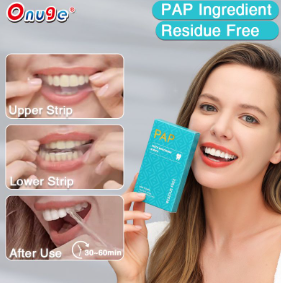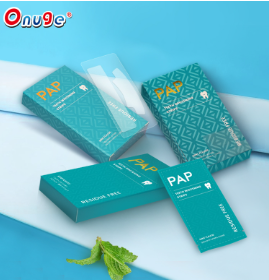If you are considering whitening your teeth and looking at all the options, you may have come across PAP teeth whitening. Hydrogen peroxide is widely used as the main ingredient in tooth whitening treatments, but PAP is becoming increasingly popular.
However, because it is relatively new, not many dentists use it and some people have not even heard of it yet.
This article will discuss all you need to know about PAP teeth whitening and answer the following questions so you can decide if it is the method you want to use.

These include:
(1) What is PAP Teeth Whitening?
(2) Does PAP whiten teeth in the same way as hydrogen peroxide-based products?
(3) How does it work?
There are many benefits to using PAP teeth whitening products, especially if you don't want a product that has peroxide as its main ingredient. So let's start by understanding exactly what PAP is and how it whitens your teeth.
(1) What is PAP Teeth Whitening?
PAP stands for phthalimide peroxyhexanoic acid and is the main whitening ingredient in some whitening products. brands such as Hismile, Smile Avenue and Onuge use PAP or PAP+ as the main ingredient in all their whitening products, including PAP whitening patches. It is a non-peroxide whitening agent that has been clinically proven to be as effective as hydrogen peroxide in whitening teeth.PAP is not as widely used as peroxide because it is a relatively new concept. However, recently, some companies have created a safe and effective formula for their increasingly popular teeth whitening patches, such as Onuge.
(2) Does PAP whiten teeth in the same way as hydrogen peroxide-based products?
It is a non-peroxide whitening agent that has been clinically proven to be as effective as hydrogen peroxide in whitening teeth.
Published literature on the use of PAP indicates that 5% PAP is approximately equivalent to 3% hydrogen peroxide and 12% PAP is equivalent to 8% hydrogen peroxide in terms of comparative bleaching effect. the bleaching effect of PAP occurs faster and more consistently than HP. Studies using scanning electron microscopy to assess surface changes have shown that the enamel surface does not degrade even after prolonged exposure to PAP bleaching gels.
Studies observed in a clinical setting have shown that changes in tooth colour occur very quickly and remain stable for up to 24 hours after bleaching. This is because PAP does not cause loss of enamel minerals and therefore does not remineralise. In addition, PAP is formulated to minimise dehydration of the teeth during the bleaching process, thus reducing rehydration. The bleaching effect is only attributable to PAP, as the use of a carrier without this active ingredient does not result in any change in tooth colour. Importantly, clinical studies have also shown that the product is well tolerated and does not cause the tooth soreness that is characteristic of using high concentrations of hydrogen peroxide in a professional bleaching gel.
PAP is an alternative to the hydrogen peroxide used to whiten teeth and has both similarities and differences when it comes to whitening teeth.
(3) Let's look at how whitening works?
There are two types of whitening: physical and chemical. Physical whitening removes stains from the surface of the teeth by rubbing, and chemical whitening bleaches the surface of the teeth and removes stains that are embedded slightly deeper.
The three main ingredients that can be used for chemical teeth whitening are
Hydrogen peroxide
Urea peroxide
Phthalimide peroxyhexanoic acid (PAP)
Each of these ingredients whitens teeth by oxidising stains and lightening the overall tooth colour. They work by entering the enamel layer and altering and breaking down the molecules that hold the colour. The smaller the molecule the lighter the colour.
The difference between these whitening ingredients is that when peroxides work, they release free radicals that can damage tooth and gum tissue.PAP does not release free radicals when it oxidises stains, making it safer for you to use it to whiten your teeth.

PAP is not as widely used as peroxides because it is a relatively new concept. Recently, however, some companies have developed a safe and effective formula that can be used in their increasingly popular whitening products. Onuge, for example, produces different formulations of teeth whitening products, including PAP and peroxide, and we also support custom We also support custom tooth whitening veneers in different flavours and shapes. We are committed to producing the best dental veneers available, so please feel free to contact us if you have any questions.
Previous: Con qué tipo de láser eliminaremos un tattoo?
Next: Fractional CO2 Laser Machine For Sale_Sincoheren since 1999
Copyright:@2020-2021
Comments Please sign in or sign up to post.
0
0 of 500 characters used